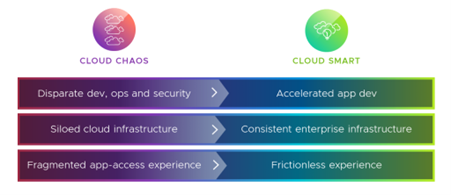
The cloud could be seen as a panacea by some. However, as a company grows and its rate of growth slows, the cloud’s potential benefits may be outweighed by the strain it puts on profit margins. The full impact of the cloud throughout an organisation’s economic lifecycle is becoming more apparent as cloud adoption spreads and industry experience grows.
VMware Explore 2022
Towards the end of 2022, I was fortunate enough to travel to Singapore for VMware Explore (previously titled VMworld), which took place on the 15th and 16th of November. The event was a get-together of all the players in the multi-cloud ecosystem, where they discussed and shared solutions for things like multi-cloud (cloud management, cloud and edge infrastructure), security, networking, hybrid workforce, cloud-native app development, DevOps, DevSecOps, and open-source.
According to a new survey conducted by Vanson Bourne for VMware, even while many businesses in the Asia Pacific region are already operating in a multi-cloud environment, the vast majority of them haven’t yet developed a multi-cloud strategy. While 70% of Asia-Pacific respondents’ firms are currently employing various public clouds, just 38% claim to have a properly defined multi-cloud strategy. Even more problematic is the fact that many companies in the Asia-Pacific region showed no clear connection between their application strategies and their cloud plans.
 In his introductory remarks, VMware CEO Raghu Raghuram remarked, “VMware and its partners are here to bring new creative services to help clients benefit from a cloud-smart strategy.” Consumers understand that a multi-cloud setting gives them the freedom to select from a variety of clouds, both domestic and international, to host their applications.
In his introductory remarks, VMware CEO Raghu Raghuram remarked, “VMware and its partners are here to bring new creative services to help clients benefit from a cloud-smart strategy.” Consumers understand that a multi-cloud setting gives them the freedom to select from a variety of clouds, both domestic and international, to host their applications.
In The Beginning, There Was Chaos
According to a recent survey, 80% of businesses are already operating in a position that can best be described as “cloud chaos,” where more cloud availability has led to a dramatic increase in complexity. The majority of companies say that it is time-consuming and costly to create new applications and that it is much more challenging to manage a complete portfolio of apps across many cloud platforms. There’s a good reason for this: Different clouds all demand the usage of incompatible, proprietary tools for their own teams. However, it might be difficult for the common worker to gain quick, safe access to mission-critical software regardless of location. The effects of this complexity on the organisation are far-reaching, touching on everything from cost control to employee retention.
The Smart of War
Cloud Smart – This is the end goal of any multi-cloud strategy, a more developed and flexible method in which you may choose the cloud that best suits each particular application. Most of the customers that have successfully implemented a cloud-smart strategy mention three major changes they implemented on their journey from Cloud Chaos to Cloud Smart:

 The results are in, and businesses in our region are dedicated to adopting a cloud-first mentality but many are hitting a ceiling in their multi-cloud adoption. “Many enterprises are at risk of entering a state of ‘Cloud Chaos,’ losing visibility and control as more and more of their apps and data are scattered over more and more clouds,” said Paul Simos, VMware’s Vice President and Managing Director, Southeast Asia and Korea. When it comes to multi-cloud, businesses need to get the most out of their money. To prepare for the future, businesses need to adopt a cloud-savvy strategy that will allow them to maintain the same level of productivity and profitability they’ve seen since they began working in the cloud.
The results are in, and businesses in our region are dedicated to adopting a cloud-first mentality but many are hitting a ceiling in their multi-cloud adoption. “Many enterprises are at risk of entering a state of ‘Cloud Chaos,’ losing visibility and control as more and more of their apps and data are scattered over more and more clouds,” said Paul Simos, VMware’s Vice President and Managing Director, Southeast Asia and Korea. When it comes to multi-cloud, businesses need to get the most out of their money. To prepare for the future, businesses need to adopt a cloud-savvy strategy that will allow them to maintain the same level of productivity and profitability they’ve seen since they began working in the cloud.
The Smarter Cloud Initiative
From what I have gathered in multiple sessions I have been to with the leaders and experts from VMware, organisations in Asia and the Pacific need to focus on the following six areas to take the next step toward becoming “Cloud Smart:”
- Unlocking revenue and profitability potential: Although businesses in the Asia-Pacific region believe that a multi-cloud environment is essential to their future success, the advantages are far more pronounced and obvious for Cloud Smart businesses. 97% of Cloud Smart businesses in the Asia Pacific say their multi-cloud strategy has increased sales and profitability.
- Transforming data into money: The commercialisation of data is rapidly expanding. Among APJ businesses, 30% now see data monetisation as a key revenue driver, up from only 22% two years ago. 41% of Cloud Smart companies say data monetisation is a major income stream now, and 75% expect it to be so by 2027.
- Demystifying visibility to control cloud costs: Companies are seeing a decline in profits due to a lack of oversight and management of their multi-cloud operations. When comparing Cloud Smart and Cloud Chaos companies, it’s clear that the latter is having a far tougher time managing their cloud expenditures.
- Tackling data sovereignty and management: A growing amount of information is being gathered from clients all across the world. Concurrently, governments are pressuring businesses to store acquired data within their own territories. With 92% of Cloud Smart firms reporting it is straightforward to manage data in whatever nation it sits, compared to 63% of Trailing enterprises, multi-cloud clearly helps organisations meet the rising data sovereignty challenges. Moreover, compared to just 60% of their Trailing counterparts, Cloud Smart businesses say it is simple to safeguard data wherever it lives on the cloud.
- Strengthening security and control: More clouds means more places where nasty things can sneak in. It’s perhaps not surprising that 61% of APJ organisations surveyed say they need to improve their cybersecurity strategy in order to successfully secure apps and data across multiple clouds, given the lack of visibility and control over their multi-cloud environment. When asked about the security of their company’s data, 93% of Cloud Smart companies, 93% of end-user employees, and 92% of customers all said there was little or no room for improvement.
- Bridging the talent gap: The shortage of qualified employees is another problem that must be overcome for multi-cloud to be successful. In the Asia-Pacific region, over half (46%) of respondents feel their company lacks the in-house capabilities necessary to implement a multi-cloud strategy; even Cloud Smart companies (42%) face this challenge. With regards to attracting and keeping top talent, 91% of Asia Pacific respondents said that having a well-defined multi-cloud strategy was essential.
VMware also unveiled offerings aimed at assisting customers in running, scaling, and protecting enterprise workloads across private and public clouds and at the edge, as part of a Cloud Smart approach to multi-clouds, which will be useful to organisations as they move into the next phase of their cloud journey.
Stay tuned for more coverage from Singapore by yours truly.




